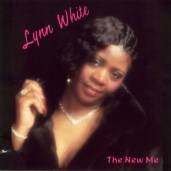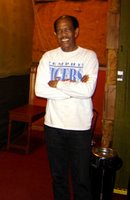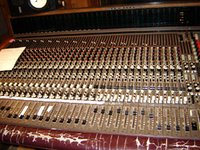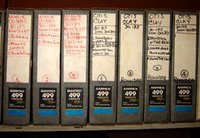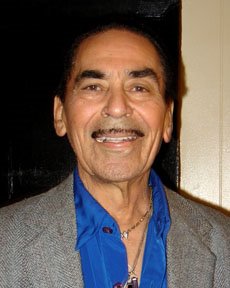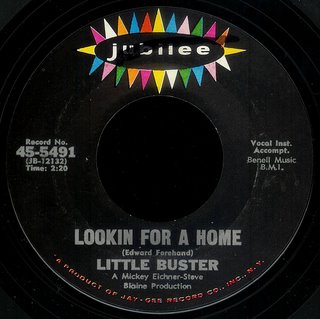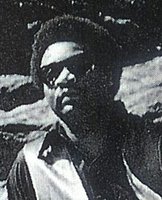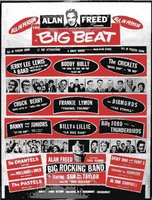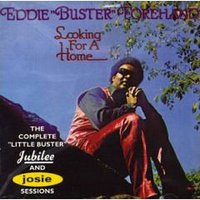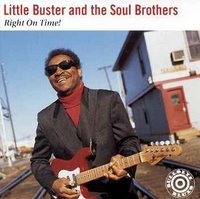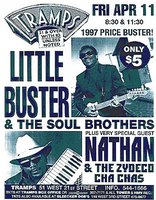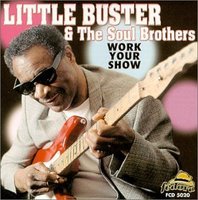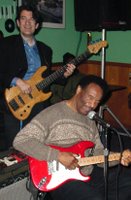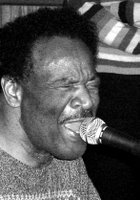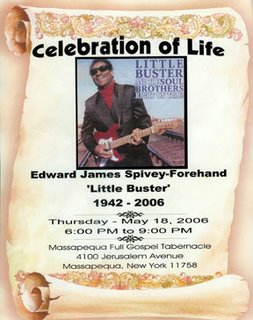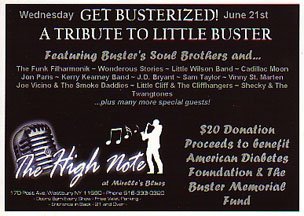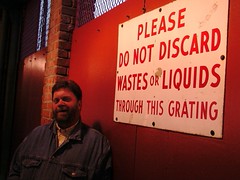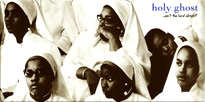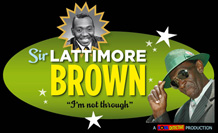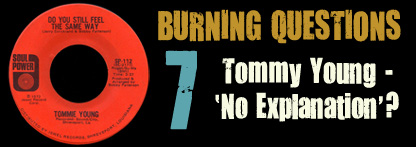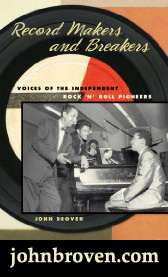 What Am I Living For
What Am I Living ForToday is my 13th wedding anniversary (well, it's my wife's too), and I figured it was a good day to post this one...
In the mid 1920s in the Black Bottom section of Philadelphia, a woman named Eleanora Moore had a vision. 'A child is coming to lead the people', she was told, 'prepare his Church'. For the next 12 years, she and her husband worked tirelessly to create 'The House Of God For All People', and when her grandchild was born unto them, they named him Solomon, as he was to become a wise and just King of the Congregation...Whether that was in 1936 or 1940 is still a matter of speculation. By age seven, the child was preaching from the pulpit. By the time he was twelve years old, he was the host of his own radio show from 'Solomon's Temple' in Philadelphia. Known as the 'wonder boy preacher', he built up quite a following.
 Bess Berman
Bess Berman heard him and signed him to her
Apollo Records label in 1954.
Roy Hamilton had just broken the sound barrier, so to speak, when his gospel tinged
You'll Never Walk Alone hit number one on the R&B charts and stayed there for two months. Apollo envisioned Solomon in the same vein, releasing answer songs like "I'm All Alone" and "No Man Walks Alone" that didn't make much noise in the charts. He continued to record both Gospel and R&B for the Bermans, while going to school to become a Doctor of Mortuary Science. After a couple of singles on the local Singular label, Solomon found himself in a 'handshake' deal with
Jerry Wexler to record for Atlantic Records.
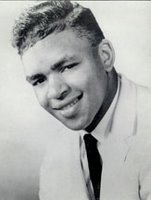
After Ray Charles left Atlantic for his mega-deal with ABC, the company was kind of floundering around, looking for the next big thing. As the story goes, they recorded
Just Out Of Reach (of My Two Open Arms) (which was a minor country hit for Faron Young in 1952), in New York while a blizzard raged outside. Wexler wasn't happy with the way Solomon "preached" the last verse of the song, telling him "This is R&B, son, not Gospel!" When it came time to listen to the take they had recorded, Burke was already leaving... he had a gig driving a snow removal truck back in Philly! This episode would set the tone for his relationship with Atlantic throughout his tenure with them, one they were never too happy about; they needed him more than he needed them.

The record hit big in 1961, spending 19 weeks on the R&B charts while climbing to #7, as well as crossing over into the pop top 40. Ironically, it was to set the stage for Ray Charles' smash hit the following year with a similarly schmaltzy production of
Don Gibson's
I Can't Stop Loving You. (This must have driven Wexler crazy!) Anyway, when Burke's follow-up record,
Cry To Me, went to #5, Atlantic knew they had a star on their hands.

Solomon hit the road, traveling with the legendary 'package shows' of the day. He didn't drink or gamble, and came to be known as "The Doctor", or simply "Bishop" to the gang on the bus. The stories from this period (and there are indeed stories!) are simply fantastic. Ever the entrepeneur, Solomon sold everything from bologna sandwiches (that increased in price as the miles wore on), to chicken and 'magic popcorn'. While he developed some deep and lasting friendships among his fellow performers on these tours, he grew to simply idolize
Sam Cooke, the only one who could beat him at his own game.
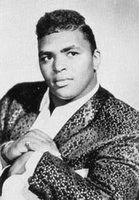
The hits kept on coming for Solomon, and his cover of
Wilson Pickett's
If You Need Me would spend 5 weeks at #2 in the summer of 1963 (only kept from the number one position by Jackie Wilson's
Baby Workout and Sam Cooke's
Another Saturday Night!). According to Burke, Wilson gave the song to him on a tour bus, but that's not the way Pickett remembers it at all... he claims Wexler lifted it from demo tapes he had sent Atlantic, which is a much more likely scenario.

After charting consistently for over three years, Solomon was crowned the "King Of Rock And Soul" by Baltimore DJ
Rockin' Robin. He would take this title to heart, and appear complete with crown, scepter and cape from that day forward. This, of course, drove self-proclaimed 'hardest working man in show business'
James Brown up the wall, and the stories of his attempts to 'de-crown' him are hilarious.
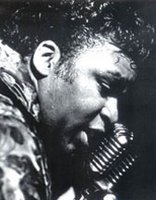
Solomon Burke was with his hero Sam Cooke on the night he was shot. He couldn't believe it. In his own words, it really "messed him up", for quite a while. His wife served him with divorce papers the following day, and on the train back to Chicago for Sam's funeral he would write his biggest hit (#1 R&B, #22 pop),
Got To Get You Off My Mind, about the whole situation. He would collaborate with his friend
Don Covay to write the follow-up,
Tonight's The Night, which was just about as big a hit in the summer of 1965.
Atlantic, by this time, was cranking out hit records by Wilson Pickett and
Aretha, and reaping the rewards of their distribution deal with Stax on people like
Otis Redding and
Eddie Floyd. King Solomon, with his string of funeral homes, churches spread nationwide, a limousine service, and several drug stores to his credit, was not high on their list. The feeling was mutual. After failing to crack the top ten for a couple of years, Atlantic sent him down to Memphis in early 1968 to record at
Chips Moman's American Studio. Although these records didn't chart, I think they're among his best.
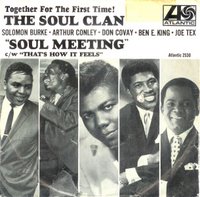
An idea that Solomon and Don Covay had been working on for some time,
The Soul Clan, had finally begun to take shape in 1967. The idea was for all of these great performers to pool their talents and resources, and become a positive force within the black community. They envisioned things like buying ghetto real estate and refurbishing it, providing jobs, building schools, and creating black-owned restaurant franchises that would knock the McDonald's and KFCs out of the box... the possibillities were endless.
Originally, it was to include Otis Redding, Wilson Pickett,
Joe Tex, Solomon, and Don Covay. When Otis died in late 1967, Pickett backed out as well saying, "I got my own hit records, I don't need that shit!". They were replaced with Redding's sidekick,
Arthur Conley, and former Drifter
Ben E. King. Covay put together the backing tracks out in L.A., and each of the artists overdubbed their vocals in turn. The resulting single hit the charts in July of 1968, and climbed to #34. At this point, Solomon Burke claims, "The record was stopped and banned...we were going against the grain of what black entertainers are supposed to do. We were all just supposed to go out and buy red Cadillacs. We weren't supposed to go out and start talking about spending millions of dollars on building and developing... We were supposed to talk about having parties and good times and eatin' barbecue ribs. You know, pork chops."
In any event, he was done with Atlantic after that.
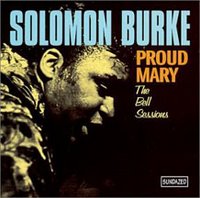
In 1969, Solomon signed with
Bell Records and showed up in Muscle Shoals with his 'partner'
Tamiko Jones. Together they would produce some of the greatest records he'd ever recorded. Today's B side is one of those. Released as the flip of
Proud Mary (#15 R&B, #45 pop), it was his second single for the label. A cover of
Chuck Willis' huge posthumous 1958 hit, it's like the pure distillation of southern soul. The interplay between the acoustic and electric guitars, the understated organ, everything just building to that big emotional finish... great stuff!
Sundazed Records has put together a package of Burke's
Bell sessions at Muscle Shoals (which had been out of print for 30 years!), and it's just incredible, eye-opening music.

Bell apparently didn't appreciate what they had, and Solomon moved on, signing with
Mike Curb's MGM label out in Hollywood in 1971. He jumped in with both feet, becoming involved with television (a failed sitcom about a black family living next door to an Archie Bunker type...), promoting a band called "Solomon's Children" (made up of the most musically inclined of his 21 children, ala the Jackson 5), and even writing the soundtrack to the cult "blaxploitation" film
Cool Breeze in 1972.

Short stints at ABC/Dunhill and Chess in the mid-seventies were followed by an album he did with
Jerry "Swamp Dogg" Williams called
Please Don't Say Goodbye To Me for the small Amherst label in 1978, followed by
Let Your Love Flow on Infinity the following year.

The eighties saw Solomon concentrating on his ever-increasing ministry, releasing several superb gospel albums on the
Savoy label. He also toured Europe regularly where he remains immensely popular to this day. When Peter Guralnick's
Sweet Soul Music came out in 1986, it introduced him and his world to a whole new group of fans... people like me.
The very first 45 I ever bought by him was the incredible
Meet Me In Church, one of those Memphis records from 1968. I put it in my jukebox (which had been a recent, cheap pick-up as all the bars and pizza places and everything were making the switch to CD ones at the time), and it has been there ever since (it's now up on
the A side as well). When I first started dating my wife, she played that song over and over again... I should have known something was up!

In the 80s and early 90s, there was a bar on 21st St. in New York named
Tramps. It was an absolutely wonderful place, an island of real music in a sea of new wave junk. Solomon, buoyed by the Rounder release of
Soul Alive!, started playing there a couple of times a year. We never missed him. (I remember one particular extravaganza boasted Solomon, Charles Brown, and Ruth Brown... when he spotted Maxine Brown in the audience, Solomon couldn't resist bringing her up to sing, roaring about how "We got THREE Browns here tonight, folks... where's the other one? Where's James? I'll tell you, he's afraid to show his face, 'cause the REAL KING is in the house!" ...what a great bar this was!)
Anyway, I proposed to my girlfriend on Valentine's Day in 1993. No date was set as yet. On May 1st of that year, the King Of Rock And Soul was coming back to Tramps. We, of course, were going. My fiance, as she was now known , came up with this crazy idea. She was going to get herself backstage, and ask The Bishop if we could hire him and his band to play at our wedding, at which he would, of course, perform the ceremony as well. I told her she was nuts! There was no way I was going back there with her and making a fool of myself, blah, blah, blah.
Solomon surveyed the situation, and, ever the showman, told her "I'm going to marry you, but I'm going to do it tonight!" He cautioned her not to mention a word of it to me when she got back to our table, and the two of them hatched their diabolical plan... Anyway, before I knew it, I was somehow getting married in the middle of his show, our vows being his usual promise to give each other "what we want, when we want it, how we want it, where we want it and every time we think we want it!". It was a total trip. Our first dance as husband and wife? Why Proud Mary, of course!
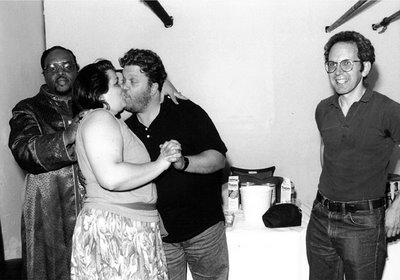
Here's our only wedding picture... (yes, that is Guralnick). It was taken by photographer Sharon Felder,
Doc Pomus' daughter. What a night.
We, of course, wondered if all of this was legal and everything, but Solomon called us the next time he was in town and invited us back to Tramps, where he delivered our Marriage Certificate from the House Of God For All People...
(My wife and I have gone on to have two great kids, and feel we have been truly blessed by the presence of The Reverend Bishop Solomon Burke in our lives...)
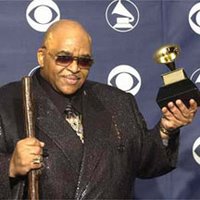
In addition to making great records (like
Soul Of The Blues) right through the nineties, Solomon, of course, has gone on to gain the recognition he so richly deserves. He was inducted into the
Rock & Roll Hall Of Fame in 2001, and received a long overdue Grammy for the phenomenal
Don't Give Up On Me in 2002.

He just recorded an album of country music in Nashville with people like
Emmylou Harris and
Gillian Welch that is due out in September and will bring him back full circle to his first hit.
"God always knows best", he says "...sometimes we project what we can't see, but only God knows what's going to happen, and He knows the best. For all of us."
Amen.

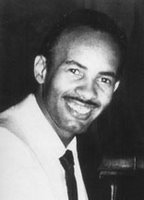 After his stints at Ace, Apollo, and Chess, Eddie landed at Joe Ruffino's Ric and Ron labels in 1960. Ruffino utilized Bo's talents to the fullest, not only using him as his new songwriter, arranger, and producer, but putting his considerable carpentry skills to work building a studio for the company. He produced great records on Tommy Ridgley, Irma Thomas, and Johnny Adams for Ruffino, in addition to cranking out his own great sides like Tell It Like It Is and Every Dog Got His Day.
After his stints at Ace, Apollo, and Chess, Eddie landed at Joe Ruffino's Ric and Ron labels in 1960. Ruffino utilized Bo's talents to the fullest, not only using him as his new songwriter, arranger, and producer, but putting his considerable carpentry skills to work building a studio for the company. He produced great records on Tommy Ridgley, Irma Thomas, and Johnny Adams for Ruffino, in addition to cranking out his own great sides like Tell It Like It Is and Every Dog Got His Day. Bo then went on to fulfill every record label owner's dream in the early 60s, he created a national dance craze that rivaled The Twist! Now there are those that say that Eddie didn't make it up, that the dance came from the kids on the streets of his old neighborhood, the Ninth Ward. There are those who credit Chris Kenner with inventing the beat on his Something You Got. There are even those that claim that Huey Smith's version came first (Huey is one of them...). All we really know for sure is that RIC 987 was released in late 1961, and is, as far as I can tell, the first 45 with "Popeye" in the title. (Huey Smith & His Clowns' "Pop-Eye" - with vocals provided by a young Curley Moore - came out as ACE 649 in 1962).
Bo then went on to fulfill every record label owner's dream in the early 60s, he created a national dance craze that rivaled The Twist! Now there are those that say that Eddie didn't make it up, that the dance came from the kids on the streets of his old neighborhood, the Ninth Ward. There are those who credit Chris Kenner with inventing the beat on his Something You Got. There are even those that claim that Huey Smith's version came first (Huey is one of them...). All we really know for sure is that RIC 987 was released in late 1961, and is, as far as I can tell, the first 45 with "Popeye" in the title. (Huey Smith & His Clowns' "Pop-Eye" - with vocals provided by a young Curley Moore - came out as ACE 649 in 1962).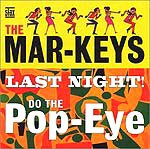 It seemed like every record company in America jumped on the bandwagon after that, not wanting to miss out on the latest fad. Stax put out a whole album of Popeye tunes by the Mar-Keys. Ernie K-Doe jumped in with "Popeye Joe" on Minit. Don Covay was doing "The Popeye Waddle" on Cameo. Chubby Checker had the biggest hit of all when "Popeye (The Hitchhiker)", the B side of his #2 pop hit "Limbo Rock", broke the top ten on its own in October of 1962.
It seemed like every record company in America jumped on the bandwagon after that, not wanting to miss out on the latest fad. Stax put out a whole album of Popeye tunes by the Mar-Keys. Ernie K-Doe jumped in with "Popeye Joe" on Minit. Don Covay was doing "The Popeye Waddle" on Cameo. Chubby Checker had the biggest hit of all when "Popeye (The Hitchhiker)", the B side of his #2 pop hit "Limbo Rock", broke the top ten on its own in October of 1962.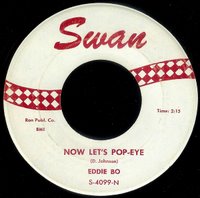 Joe Ruffino had a serious mistrust of national distribution of his records by other companies after Roulette basically stole his biggest hit, Joe Jones' "You Talk Too Much", out from under him in 1960. By the time he consented to lease Bo's original Popeye to Philadelphia's Swan Records, the dance craze had essentially run its course, and the single went nowhere.
Joe Ruffino had a serious mistrust of national distribution of his records by other companies after Roulette basically stole his biggest hit, Joe Jones' "You Talk Too Much", out from under him in 1960. By the time he consented to lease Bo's original Popeye to Philadelphia's Swan Records, the dance craze had essentially run its course, and the single went nowhere.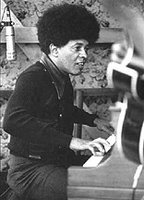 Eddie then began his odyssey of producing and recording for over 35 different labels over the years, leaving behind absolute funk masterpieces like Check Your Bucket, Pass The Hatchet, Can I Be Your Squeeze, and many more. Sometimes the records were produced on other artists, or sometimes just put out under various bizarre pseudonyms for one reason or another. His biggest hit came in 1969, when Hook And Sling (this time released under his own name) made it to #13 on the R&B charts. You can check out the dizzying array of Bo-related records at Martin Lawrie's superb Eddie Bo Discography over at Soul Generation.
Eddie then began his odyssey of producing and recording for over 35 different labels over the years, leaving behind absolute funk masterpieces like Check Your Bucket, Pass The Hatchet, Can I Be Your Squeeze, and many more. Sometimes the records were produced on other artists, or sometimes just put out under various bizarre pseudonyms for one reason or another. His biggest hit came in 1969, when Hook And Sling (this time released under his own name) made it to #13 on the R&B charts. You can check out the dizzying array of Bo-related records at Martin Lawrie's superb Eddie Bo Discography over at Soul Generation. One of the most sought after records in the Eddie Bo pantheon is the first release on a label he formed in 1964 called, aptly enough, FUN. It featured the young Snooks Eaglin (billed as Lil Snook) doing Cheetah b/w Sweetness. According to Martin Lawrie; "It is not clear if this record was ever released fully, several promo copies exist but so far as I know there are no issues." Talk about your basic Holy Grail, huh?
One of the most sought after records in the Eddie Bo pantheon is the first release on a label he formed in 1964 called, aptly enough, FUN. It featured the young Snooks Eaglin (billed as Lil Snook) doing Cheetah b/w Sweetness. According to Martin Lawrie; "It is not clear if this record was ever released fully, several promo copies exist but so far as I know there are no issues." Talk about your basic Holy Grail, huh? Anyway, I was lucky enough to see Eddie perform with Snooks (who I'm sure you know is one of my all time guitar heroes...) at the Rock N' Bowl in New Orleans while I was down there for Jazz Fest earlier this month. As far as either of them remembered, it was the first time they'd actually worked together since the release of FUN 303. It was simply amazing, man.
Anyway, I was lucky enough to see Eddie perform with Snooks (who I'm sure you know is one of my all time guitar heroes...) at the Rock N' Bowl in New Orleans while I was down there for Jazz Fest earlier this month. As far as either of them remembered, it was the first time they'd actually worked together since the release of FUN 303. It was simply amazing, man.



